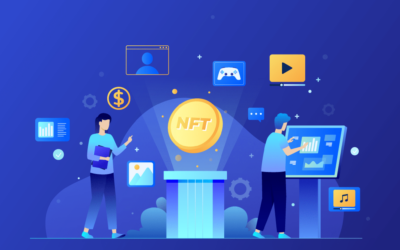Table of Content
Digital transformation is the design and execution of a plan to merge all resources with technologies, focusing on the core of the business and ways to convert it into a more competitive organization.
Every organization has a unique market position, values, culture, business goals, technologies, working teams, and perspectives—all of which make the digital transformation strategy unique for each company.
Business leaders should analyze and discuss why a company should undergo a digital transformation process and reach a shared understanding about what it will mean for the organization. What is the goal? How will the business get there?
Digital transformation decisions are generally made under pressure. Unfortunately, the transformation process is usually led by the fear of being left behind in a particular industry, and plans are often influenced by survival issues and/or competitive situations. Since hasty decisions can have undesired results, business leaders should take the time to ensure that digital transformation is a well-planned, intentional process.
Digital Transformation Strategy Alignment
Many aspects of a business are challenging to align with a digital transformation strategy. Effective business design involves the organization of people, processes, and technology in order to define a value proposition inspired by technological capabilities. The synergy in the interaction of people, process, and technology creates a responsive enterprise, from customer demands to technological advancements.
Digital success can be affected by a number of organizational changes:
Company Culture and Communication. People are the core of the digital transformation initiative. Organizational culture supports all other aspects of digital transformation. Without the support of managers who can effectively communicate the principles of digital transformation, its propositions usually fail. For a successful culture adaptation, it is best to implement an agile decision-making style—a collaborative and transparent environment that inspires creativity, risk-taking, and learning from failure. The most important aspect of a digital transformation strategy is the communication flow: establishing an effective structure of communication through which to gain team efficiency.
Management Style and Leadership. Business leaders should design and structure their companies specifically toward achieving digital success. In addition, leaders need to develop the soft skills necessary to interact effectively with teams and individuals in order to communicate empathy, provide vision and purpose, and empower employees to think differently—as well as to motivate, persuade, influence, inspire, collaborate, and support. A business organization’s digital transformation strategy is a top management job and should not be delegated to the IT department.
Goals and Visions. Business leaders should develop a set of goals to keep teams focused, create a sense of community, and build trust. Goals should be realistic, allowing managers to recognize new opportunities for employees, manage resistance to change, and successfully communicate the digital business vision.
Team Structures and Design. Leaders should envision a digital transformation strategy that includes changes in team structures and design, considering governance efforts, accountability frameworks, behavior adaptation, and group engagements, as well as fostering autonomous teams, including a flat-structure cross-functional team for experimenting and testing ideas.
Upskill Teams. Organizations need to invest in continuous learning programs with incentives to retrain and upgrade employees’ knowledge and value. Also, leaders must be prepared to manage employees’ fears of being replaced.
Business Process. Once an organization’s leaders agree on a business strategy, business models, the challenges and demands of operational processes, and the desired customer experience, they can identify how to integrate technologies with operations. An organization’s digital maturity as well as their current stage of digital transformation will determine the starting point for discussions about the workflows of operational processes.
Technology Infrastructure. It is critical for businesses to evaluate resources, user experience, and preferences in order to support development cycles. Digital transformation strategy should be embraced in phases (or stages), aligned with organizational capacity and decision cycles, and implemented according to the new business plan. Developing the optimal technology infrastructure will require long-term capital investments.
IT Architecture
Many organizations operate with legacy core systems or back-end systems with added components that have been working for years. These may not support new digital solutions and may be expensive to replace. Sometimes organizational silos exist as well, which further slow decisions and actions. Companies usually cannot eliminate all existing systems at once; therefore, most begin with their legacy systems and design their own digital platforms as their systems evolve.
Businesses need to design software systems that support organizational evolution. IT architecture involves the structure of interacting components and interfaces. Admittedly, IT environments can be complex to manage and sometimes costly to maintain with an architecture built on platforms and complicated technology stacks. Therefore, a clear understanding of business goals, technical depth, benefits and costs, complexity, team organization, and customers and end-users is necessary for strategically planning essential elements early in the project.
Legacy Architecture (Monolith). Legacy architecture (monolith) is considered the oldest model of business technology. All functions are contained within one application, making the system difficult to update and/or scale and creating significant implications in the whole application and infrastructure. Legacy architecture often hampers the digital transformation strategy, although it may be possible to build an adaptable digital platform that connects a legacy system with application networks by using APIs to support modern business. An API’s connectivity is designed in layers: system, process, and experience.
Microservices (Distributed Systems). Microservices consist of independent services designed to support specific business processes, offering more flexibility in architecture, better developer autonomy, and continuous independent deployment. They are used with customer-facing applications that require frequent updates, such as mobile apps, APIs, and web apps. They are easy to scale, replaceable, and upgradeable, with low latency, secure and reliable connectivity, dynamic responsiveness, and uncoupled services that don’t affect architecture. These distributed systems may have extra complexities but are more flexible and better for larger teams.
Agile Digital Organization. Once an organization redesigns its business architecture and aligns its management, culture, and teams with the technology infrastructure, there is a continuous flow in the digital transformation process that brings innovative products with continuous delivery and deployment techniques.
Organizations should design their digital platforms as a set of components that will support their business needs in a flexible, scalable, and technologically evolving manner. The ideal design might not currently exist and should, therefore, be custom-built into the context of the company’s technology strategy.
Digital Platforms
Building a digital platform (with all its components) is necessary to create and support new digital offerings. Digital platforms must deliver seamless experiences to different user types, including employees, customers, and/or partners. In addition, a digital platform must allow the operations model to be adapted to the business design, thereby creating higher value experiences and adoption rates.
Platform Automation and Orchestration. Platform automation and orchestration is a digital transformation strategy that reduces complexity, costs, and risks. In this strategy, IT management tasks are automated to reduce manual work and manage larger infrastructures with more agile and flexible teams. Automation adoption requires people, process design, and a platform with capabilities for running and managing it.
Automation plays a crucial role in agile application development, accelerating processes, scaling, integrating, and deploying continuously. Combined with an application programming interface (API), automation allows faster proofs of concept, development, and deployment.
Automation can also unite hybrid and multi-cloud environment processes and policies to manage and integrate operations more effectively, such as creating APIs that work within both environments.
Software Development Lifecycle (SDLC) Methodologies. The software development approach in transforming enterprises should be carefully considered and discussed in the ideation stage to minimize risks. Each type of SDLC involves unique steps in the development process, such as analyzing requirements, designing rules, testing, managing deployment, and ensuring maintenance. Modern IT operating models require fast software releases that benefit from agile methodologies, DevOps processes, and productive team structures.
Digital Technologies
Digital technologies create business opportunities for new offerings that enrich customer solutions and enhance the enterprise value proposition. Some of the most relevant technologies that should be considered in a digital transformation strategy are included here.
Cloud Computing. Cloud computing offers an environment in which applications run, deliver flexible on-demand access of resources across a network on a pay-as-you-go basis, and contain IT resource repositories. This platform enables agile mobile development, scaling resources as needed and reducing configuration complexity. The cloud is seen as the first step in modernizing IT infrastructure and improving operations, processes, and services.
There are public clouds, private clouds, hybrid clouds, and multi-clouds. Major cloud providers use application programming interfaces (APIs) and virtual private networks (VPNs) to connect with the resources. In cloud services, the stream of data flows from the user (front-end) to the system (back-end).
Cloud Service Types
- Infrastructure-as-a-Service (IaaS)
- Platform-as-a-Service (PaaS)
- Software-as-a-Service (SaaS)
- Function-as-a-Service (FaaS)
The cloud provides access to technologies to build solutions, spin-up resources (as needed), and deploy services and test new ideas faster.
Internet of Things (IoT). IoT creates business opportunities for enhancing applications or applying new features to existing products that will enrich customer solutions and enhance the value proposition. IoT technologies integrate objects with sensors and connect them to networks through APIs, creating volumes of data that must be collected, stored, and analyzed. Continuous data transmission is analyzed in real time and integrated into systems. Large and complex data sets—big data—must be set up for analytics, artificial intelligence, and machine learning.
Big Data. Information (data) is a valuable asset for businesses, a strategic component used for developing and improving products and services. Real-time data must be accessed from various sources and integrated with systems and tools, both on-premise and through cloud environments. Analytics software is utilized for developing predictions using techniques such as data mining, statistics, data modeling, artificial intelligence, and machine learning. Data should be allowed to move freely across systems and vendors with appropriate privacy and control measures in place to monitor possible usage by third-parties.
Artificial Intelligence and Machine Learning (AI/ML). The explosion of data has outpaced the ability of most organizations to make sense of it. Opportunities to translate data into new products and solutions are everywhere. New tools that triangulate data from several sources (often siloed) using algorithms now create applications that were once unimaginable. Gaining insights and deeper knowledge of customer data opens the door to developing improved products and services. It’s possible to develop AI/ML analytics services that enable multiple participants but don’t share datasets or de-identified data due to privacy and security risks.
Artificial intelligence is transforming business models and reshaping marketplaces, creating new value propositions and solving real-world problems. Analytical service partners for industries are in high demand, encouraging the development of software platforms with methods and algorithms such as neural networks, machine learning, augmented intelligence, affective computing, live transcription, object recognition, speech recognition, voice recognition, voice synthesis (voice imitation), and others.
Mobile Applications. Mobile applications are essential marketing tools for new or enhanced digital offerings. Enterprise mobility is one of the most transformative approaches to improving productivity. Productivity apps are designed to create improvements by integrating with corporate data and enterprise applications. These apps are customized to solve problems and serve an organization’s specific needs, with features like workflow management automation, task management, project management, productivity analysis, and increased cross-team collaboration.
Productivity apps solve problems not only related to labor but also in other areas of the business, such as production, logistics, finance, and administrative processes, for example. The bottleneck or area of improvement is usually specific to the organization, many times making a customized application the best option. Custom apps, in particular, drive efficiency and effectiveness, provide high data privacy and security, and integrate with third-party apps using encrypted technology.












Hey 👋! I just finished reading your blog post on Digital Transformation Strategy in 2023 🤯! I’m totally vibing with the IoT and Big Data discussions 📈. Can you pls elaborate more on how these concepts can be integrated into a digital strategy? How do businesses develop a comprehensive digital transformation strategy that leverages IoT, AI, ML, and big data analytics? Love to hear your thoughts 💡
I totally feel you! You’re eager to dive deeper into the world of Digital Transformation Strategy in 2023. To integrate IoT, AI, ML, and Big Data Analytics into a comprehensive digital strategy, consider starting with a thorough analysis of your organization’s core business goals and market position. This will help you create a unique digital transformation plan that leverages these technologies to enhance customer solutions and value propositions. Don’t forget to establish a collaborative and transparent environment that supports organizational culture and communication. And, as you develop your strategy, keep in mind the importance of phased implementation aligned with organizational capacity and decision cycles. Good luck!
I appreciate the thought-provoking discussion on designing software systems for organizational evolution and navigating legacy architecture in digital transformation projects. However, I would like to suggest that a more robust analysis of the interplay between business goals, technical capabilities, and digital strategy is necessary. A clear digital transformation consultancy approach can help bridge the gap between legacy architecture and modern applications.
A well-structured digital strategy, coupled with expertise from a reputable digital consultancy, can alleviate some of the complexities associated with integrating APIs and connecting legacy systems to new platforms.